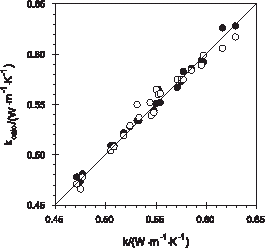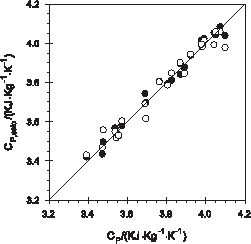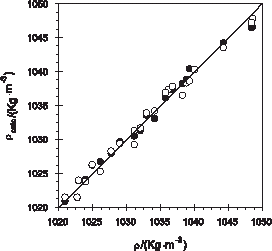Abstract
The accurate determination of thermophysical properties of milk is very important for design, simulation, optimization, and control of food processing such as evaporation, heat exchanging, spray drying, and so forth. Generally, polynomial methods are used for prediction of these properties based on empirical correlation to experimental data. Artificial neural networks are better suited for processing noisy and extensive knowledge indexing. This article proposed the application of neural networks for prediction of specific heat, thermal conductivity, and density of milk with temperature ranged from 2.0 to 71.0°C, 72.0 to 92.0% of water content (w/w), and 1.350 to 7.822% of fat content (w/w). Artificial neural networks presented a better prediction capability of specific heat, thermal conductivity, and density of milk than polynomial modeling. It showed a reasonable alternative to empirical modeling for thermophysical properties of foods.
1. Introduction
Studies on milk are very important for several reasons. It is a great source of nutrients for humans, being composed basically of water (87.0%), proteins (3.5%), lipids (3.0%), and lactose (4.5%); a large number of dairy products are available including cheese, pasteurized milk, ice cream, yoghurt, etc.; as well as great financial resources and number of people involved in the dairy industry.
Design, simulation, optimization, and control of food processing such as evaporation, heat exchanging, spray drying, and mixing are important techniques for cost decreasing and quality improvement. Also, they facilitate the training of food process operators, helping processing plants to remain competitive in the current market.
Modeling of such process requires the knowledge of basic engineering properties of foods,Citation1 such as the thermophysical properties thermal conductivity (k), specific heat (Cp ), and density (ρ). Since predicting thermal properties based on theoretical foundation is difficult, experimental measurements have been made for polynomial regression.Citation2 Thermal conductivity and specific heat may be determined using a low cost and simple method, as described by Bellet et al.Citation3 Density may be obtained by pycnometry.
The purpose of this work was to apply artificial neural networks (ANN) to develop a model for prediction of the thermophysical properties k, Cp , and ρ of milk as a function of temperature (T), water content (w w ), and fat content (w f ). Neural networks were trained by back propagation algorithm considering the independent variables (T, w w , and w f ) as input and (k, Cp , and ρ) as output. The results of prediction by neural network were compared with those by polynomial regression analysis.
2. Artificial Neural Networks
Artificial neural networks (ANN) are inspired by the nervous biological architecture systems consisting of relatively simple systems working in parallel to make quick decisions. ANN are made of a large number of computer elements, the so called nodes or artificial neurons, which are disposed in a parallel structure. Those elements are connected by means of artificial synapses symbolized by a matrix of numbers (weights), which can be adjusted by a learning process. An ANN has one input layer containing one node for each independent variable, one or more hidden layers, where the data are processed, and one output layer, containing one node for each dependent variable.Citation4 The data from the input layer are propagated through the network via synapses, which are associated with a scalar weight w ij . A popular algorithm for adapting the weights is the simple least mean square—LMS.Citation5
A general neuron symbol is showed in Fig. . This symbolic representation shows a set of weights and the neurons processing unit, or node. The total activation x j is given by the following relationship:
Figure 1. Symbolic representation of a neuron consisting of a processing node and synaptic connections.
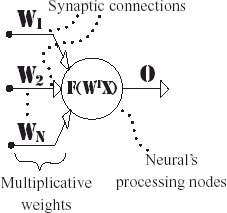
Once the node calculates x j , the result is passed to a differentiable nonlinear transfer function, f() to calculate the output of the node. The functional form of f() is
The learning process consists in identifying the weights w ij that produce the best fit of the predicted outputs over the entire training data set. Multi layer perceptron has been applied successfully to solve many problems by means of supervised learning. ANN have been used in those situations where no good physical models of the process are available and the number of outputs is greater than one.Citation6
Artificial neural networks have been the focus of interest in many fields of science and technology. Some examples can be pointed out such as data classification, function approximation (modeling), prediction (processes control, microbial growth), function optimizing, correcting corrupted data or completely missing data.Citation7
A number of articles involving ANN have been published in food and chemical engineering, and good results have been reported. ANN was applied in microbial growth modeling.Citation8 Therdthai and ZhouCitation9 Citation10 used ANN in modeling of electrical conductivity of recombined milk. Iliuta et al.Citation11 used ANN to predict vapor–liquid equilibrium for mixed dual-solvents single electrolyte systems. Buns et al.Citation12 applied ANN to predict physical properties of pure components and mixtures from molecular structures.
3. Materials and Methods
A. Database
Specific heat, thermal conductivity, and density of crude bovine milk as a function of temperature, water, and fat content were previously determined.Citation13 A database of 81 experimental points was used for this work.
B. Network Training Procedure
Multiple hidden layers were tested but it was not found to be an advantage in using more than one. Hence a three-layer network was used to predict the thermophysical properties of milk using the back-propagation algorithm. A sigmoid transfer function (Eq. (Equation3)) was used because of its useful capability for nonlinear relationship. The three independent variables (T, w w , and w f ) were used as input neurons for the network. The output neurons were composed of the dependent variables k, C P , and ρ. Training parameters for the network were obtained by trial and error.
To train the net, a variant of the back propagation technique, known as the momentum learning method, was used for both the hidden and the output layers. The values of each of the learning rule parameters were determined by several trial and error efforts, as there are no fast and deterministic rules available for this. These parameters are highly dependent on the data to be analyzed and require some degree of experience and insight into the problem to be solved. Fifty eight (58) patterns were randomly selected for training, while 17 patterns were used for testing and 6 for generalization.
The input data were normalized according to Eq. (Equation4):
The output data were normalized according to Eq. (Equation5):
After training, performance of the network was tested. Experimental values of thermophysical properties were compared with the one predicted by the net and the correlation between the experimental and predicted values were determined. Also residue dispersion, which is another indicative of good prediction, was analyzed. These results were compared with the polynomial regression, made using the SAS statistical package.Citation14
4. Results and Discussion
Learning rate and momentum coefficient were obtained by trial and error. The objective here was to determine values of these parameters which minimize the root mean squared error (RMS) between prediction of ANN and the actual, k, C P , and ρ. The net was trained in a batch mode with 10,000 epochs and RMS was evaluated with the test patterns. The best result was obtained with learning rate, 0.3 and momentum coefficient, 0.1.
The number of hidden neurons is important for the effectiveness of a network. An excessive number of neurons may lead the net to memorize the training patterns, i.e., the general characteristics of the patterns will not be extracted during the training step and the generalization will not be reached (this is called overfitting). On the other hand, if the number of hidden neurons is small the net may not converge during the training step. Thus, to avoid this problem one can estimate the minimum value of the RMS with the test patterns during training. Figure exhibits the behavior of the RMS for the test patterns when the number of nodes in the hidden layer was increased. It can be concluded that the network architecture of 3-7-3 was found suitable for the case presented.
Figure 2. Mean squared error of test data set for one hidden layer net, using the momentum learning method.
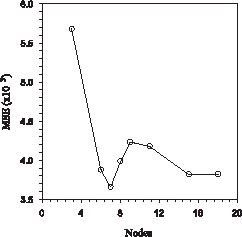
In order to establish ANN as a plausible alternative to the polynomial regression method for predicting milk thermophysical properties, the results obtained by ANN were compared with those obtained using polynomial functions.Citation13 The results of such predictions are plotted along with the predictions of ANN and actual values in Figs. , , . It was observed that residuals vary randomly, indicating the good adequacy of both models. Also, a better performance of ANN was obtained with the residuals closer to the line y = x. It must be mentioned that the prediction by ANN was made using the test and generalization group data, which were not presented to the network during the training step.
The ability of ANN to predict the thermophysical properties of milk was demonstrated. As can be seen, good agreement was achieved for both k, c P , and ρ. The values of the RMS were 2.82 × 10−2, 5.14 × 10−3, and 9.03 × 10−1, respectively. Polynomial regression also provided a good relationship between predicted and actual. The values of the RMS were 4.25 × 10−2, 7.40 × 10−3, and 9.65 × 10−1 for k, Cp , and ρ, respectively.
Polynomial models have been developed to predict thermophysical properties of foods as a function of temperature and water content, including coffee extract,Citation15 orange juice,Citation16 reconstituted milk,Citation17 and apple juice.Citation18 All these works reported good correlations for predicting these properties, some of them indicating the squared multiple correlation coefficient R 2 around 0.99. However, when another independent variable (such as w f ) is added and a more extensive region of interest is considered, the accuracy of the model based on polynomials usually decreases. Minim et al.Citation13 reported values for the squared multiple correlation coefficient R 2 of 0.970, 0.962, and 0.985 for k, c p , and ρ, respectively.
In empirical modeling, each variable used has a significant impact in most models. On the other hand, no single node within a neural network is directly responsible for associating a certain input with a certain output. This places ANN as more suited for processing noisy and extensive knowledge indexing. In this work, a better R 2 for k, C p , and ρ (0.987, 0.984, and 0.987 respectively) was obtained.
5. Conclusion
This work presented a comparative study of modeling the thermophysical properties of milk as a function of T, w w , and w f , considering the classical empirical model and ANN. Despite the good correlation obtained by polynomial regression, the performance of ANN was better, due to its higher capacity to process noisy data and a large amount of information. It can be concluded that ANN is a feasible alternative to the polynomial regression method for predicting thermophysical properties of foods.
Note
The code (in FORTRAN) of the neural model is available. Please, contact the corresponding author.
Acknowledgment
The authors wish to thank FAPEMIG—MG, Brazil for the financial support.
References
- Savaracos , G.D. and Kostaropoulos , A.E. 1975 . Transport properties in processing of fruits and vegetables . Food Technol. , 49 : 99 – 109 .
- McMinn , W.A.M. and Magee , T.R.A. Measurement and Prediction of Thermal Properties of Potatoes . Proceedings of 11th International Drying Symposium . Halkidiki, Greece. Vol. A , pp. 747 – 753 .
- Bellet , D. , Sengelin , M. and Thirriot , C. 1975 . Determination des proprietes thermophysiques de liquides non-newtoniens a l’aide d’une cellule a cylindres coaxiaux . Int. J. Heat Mass Tran. , 18 ( 10 ) : 1177 – 1187 . [CROSSREF]
- Baughman , D.R. and Liu , Y.A. 1995 . “ Fundamental and practical aspects of neural computing ” . In Neural Networks in Bioprocessing and Chemical Engineering 21 – 105 . San Diego : Academic Press .
- Zurada , J.M. 1995 . “ Multilayer feedforward networks ” . In Introduction to Artificial Neutral System 163 – 235 . St. Paul : West Publishing Company .
- Huang , B. and Mujumdar , A.S. 1993 . Use of neural networks to predict industrial dryer performance . Dry. Technol. , 1 : 525 – 532 .
- Basheer , I.A. and Hajmeer , M. 2000 . Artificial neural networks: fundamentals, computing, design, and application . J. Microbiol. Meth. , 43 : 3 – 31 . [CSA] [CROSSREF]
- Jeyamkondam , S. , Jayas , D. and Holley , R.A. 2000 . Microbial growth modeling with artificial neural networks . J. Microbiol. Meth. , 64 : 343 – 354 .
- Therdthai , N. and Zhou , W. 2000 . Artificial neural network modeling of electrical conductivity property of recombined milk . J. Food Eng. , 50 : 107 – 111 . [CROSSREF]
- Therdthai , N. and Zhou , W. 2002 . Hybrid neural modeling of the electrical conductivity property of recombined milk . Int. J. Food Prop. , 5 : 49 – 61 . [CROSSREF]
- Iliuta , M.C. , Iliuta , I. and Larachi , F. 1999 . Vapour–liquid equilibrium data analysis for mixed solvent-electrolyte systems using neural networks . Chem. Eng. Sci. , 55 : 2813 – 2825 . [CROSSREF]
- Buns , A.P. , Braun , B. and Janowsky , R. 1999 . Quantitative structure–property relationships and neural networks; correlation and prediction of physical properties of pure components and mixtures from molecular structure . Fluid Phase Equilibr. , 158 ( 160 ) : 367 – 374 . [CROSSREF]
- Minim , L.A. , Coimbra , J.S.R. , Minim , V.P.R. and Telis-Romero , J. 2002 . Influence of temperature and water and fat contents on the thermophysical properties of milk . J. Chem. Eng. Data. , 47 : 1488 – 1491 . [CROSSREF]
- SAS Institute Inc. 1999 . SAS User's Guide: Statistics, , Version 8 Ed. North Caroline : Cary .
- Telis-Romero , J. , Gabas , A.L. , Polizelli , M.A. and Telis , V.R.N. 2000 . Temperature and water content influence on thermophysical properties of coffee extract . Int. J. Food Prop. , 3 : 375 – 384 .
- Telis-Romero , J. , Telis , V.R.N. , Gabas , A.L. and Yamashita , F. 1998 . Thermophysical properties of Brazilian orange juice as affected by temperature and water content . J. Food Eng. , 38 : 27 – 40 . [CROSSREF]
- Reddy , Ch.S. and Datta , A.K. 1994 . Thermophysical properties of concentrated reconstituted milk during processing . J. Food Eng. , 21 : 31 – 40 . [CROSSREF]
- Constenla , D.T. , Lozano , J.E. and Crapiste , G.H. 1989 . Thermophysical properties of clarified apple juice as a function of concentration and temperature . J. Food Sci. , 54 : 663 – 668 .
